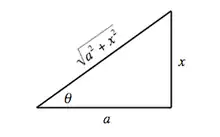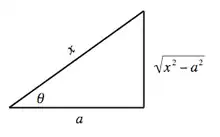| Trigonometry |
|---|
 |
| Reference |
| Laws and theorems |
| Calculus |
| Part of a series of articles about |
| Calculus |
|---|
In mathematics, trigonometric substitution is the replacement of trigonometric functions for other expressions. In calculus, trigonometric substitution is a technique for evaluating integrals. Moreover, one may use the trigonometric identities to simplify certain integrals containing radical expressions.[1][2] Like other methods of integration by substitution, when evaluating a definite integral, it may be simpler to completely deduce the antiderivative before applying the boundaries of integration.
Case I: Integrands containing a2 − x2
Let and use the identity
Examples of Case I

Example 1
In the integral
we may use
Then,
The above step requires that and We can choose to be the principal root of and impose the restriction by using the inverse sine function.
For a definite integral, one must figure out how the bounds of integration change. For example, as goes from to then goes from to so goes from to Then,
Some care is needed when picking the bounds. Because integration above requires that , can only go from to Neglecting this restriction, one might have picked to go from to which would have resulted in the negative of the actual value.
Alternatively, fully evaluate the indefinite integrals before applying the boundary conditions. In that case, the antiderivative gives
as before.
Example 2
The integral
may be evaluated by letting where so that and by the range of arcsine, so that and
Then,
For a definite integral, the bounds change once the substitution is performed and are determined using the equation with values in the range Alternatively, apply the boundary terms directly to the formula for the antiderivative.
For example, the definite integral
may be evaluated by substituting with the bounds determined using
Because and
On the other hand, direct application of the boundary terms to the previously obtained formula for the antiderivative yields
as before.
Case II: Integrands containing a2 + x2
Let and use the identity
Examples of Case II

Example 1
In the integral
we may write
so that the integral becomes
provided
For a definite integral, the bounds change once the substitution is performed and are determined using the equation with values in the range Alternatively, apply the boundary terms directly to the formula for the antiderivative.
For example, the definite integral
may be evaluated by substituting with the bounds determined using
Since and
Meanwhile, direct application of the boundary terms to the formula for the antiderivative yields
same as before.
Example 2
The integral
may be evaluated by letting
where so that and by the range of arctangent, so that and
Then,
The integral of secant cubed may be evaluated using integration by parts. As a result,
Case III: Integrands containing x2 − a2
Let and use the identity
Examples of Case III

Integrals like
can also be evaluated by partial fractions rather than trigonometric substitutions. However, the integral
cannot. In this case, an appropriate substitution is:
where so that and by assuming so that and
Then,
One may evaluate the integral of the secant function by multiplying the numerator and denominator by and the integral of secant cubed by parts.[3] As a result,
When which happens when given the range of arcsecant, meaning instead in that case.
Substitutions that eliminate trigonometric functions
Substitution can be used to remove trigonometric functions.
For instance,
The last substitution is known as the Weierstrass substitution, which makes use of tangent half-angle formulas.
For example,
Hyperbolic substitution
Substitutions of hyperbolic functions can also be used to simplify integrals.[4]
In the integral make the substitution
Then, using the identities and
See also
References
- ↑ Stewart, James (2008). Calculus: Early Transcendentals (6th ed.). Brooks/Cole. ISBN 978-0-495-01166-8.
- ↑ Thomas, George B.; Weir, Maurice D.; Hass, Joel (2010). Thomas' Calculus: Early Transcendentals (12th ed.). Addison-Wesley. ISBN 978-0-321-58876-0.
- ↑ Stewart, James (2012). "Section 7.2: Trigonometric Integrals". Calculus - Early Transcendentals. United States: Cengage Learning. pp. 475–6. ISBN 978-0-538-49790-9.
- ↑ Boyadzhiev, Khristo N. "Hyperbolic Substitutions for Integrals" (PDF). Archived from the original (PDF) on 26 February 2020. Retrieved 4 March 2013.